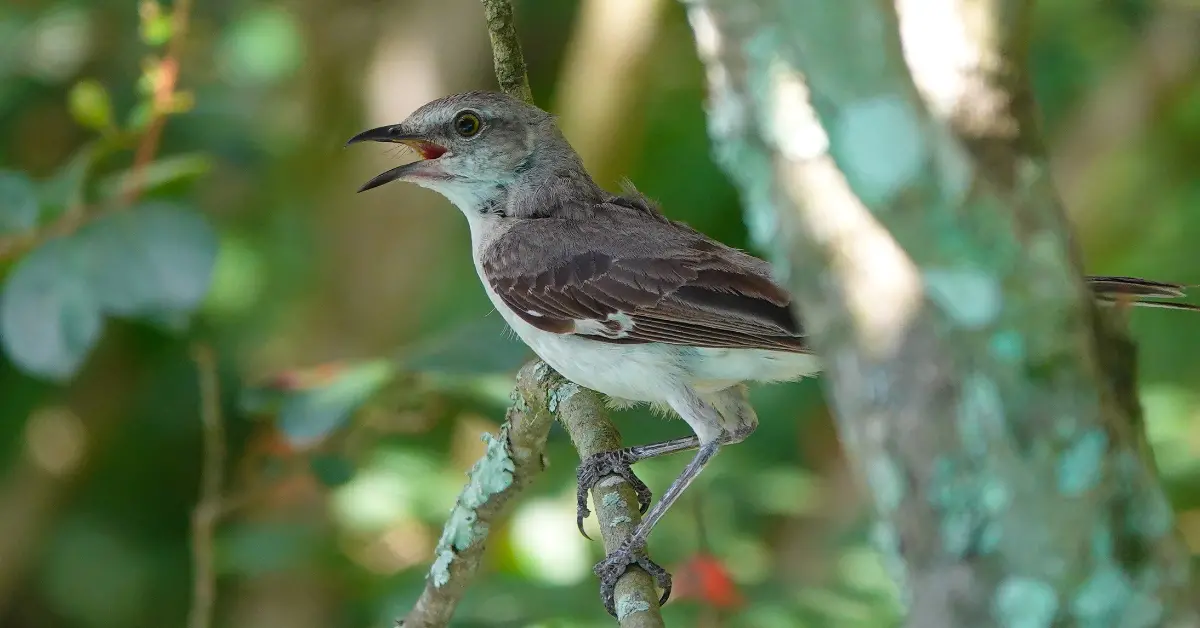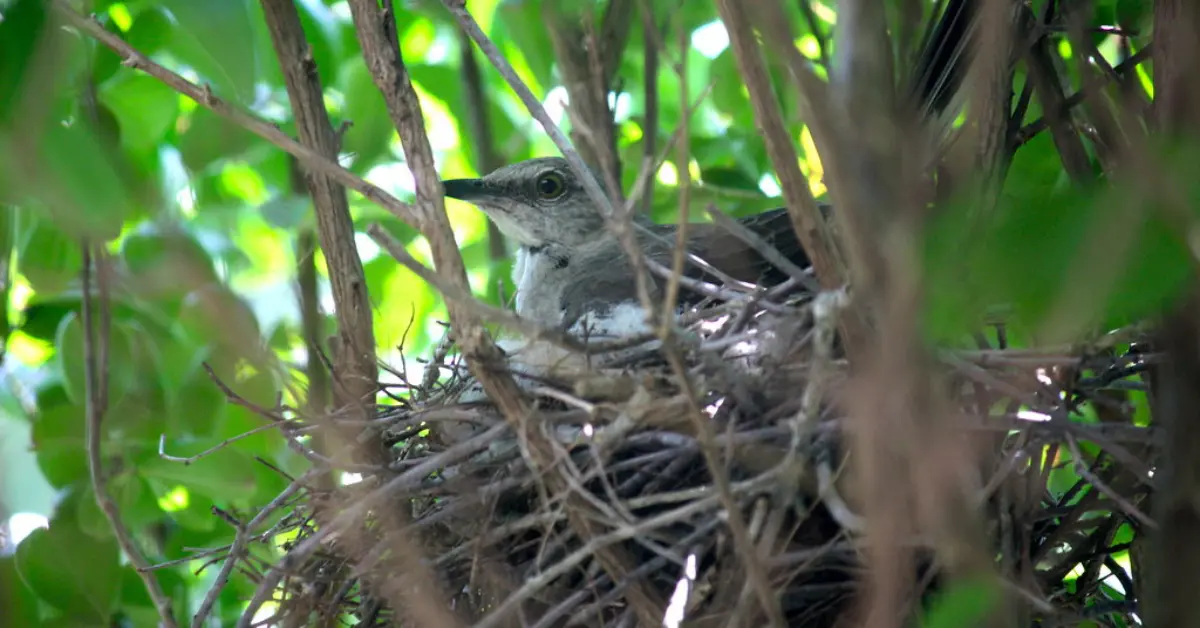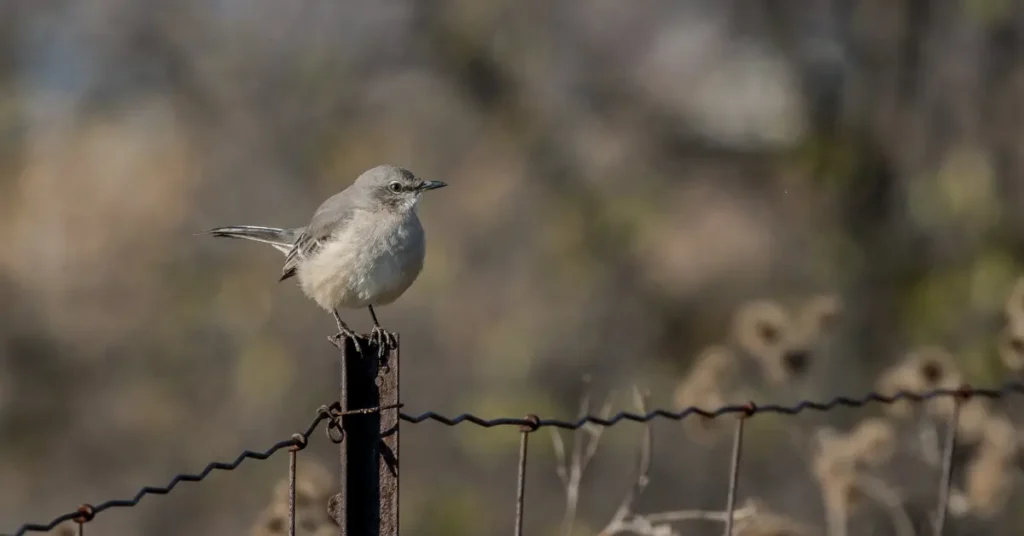The Northern Mockingbird is one of North America’s most iconic birds. With cultural references in famous books like To Kill a Mockingbird and The Hunger Games: Mockingjay, this bird has woven its way into our collective consciousness.
But what makes this bird so unique? Read on to learn ten incredible facts about the Northern Mockingbird.

1. The Northern Mockingbird: North America’s Beloved Mimic
One of the most fascinating things about the Northern Mockingbird is its ability to mimic other sounds. Mockingbirds not only mimic other bird species’ songs, but also dogs, cats, frogs, and mechanical sounds such as gate squeaks and tire squeals.
Interestingly, mockingbirds don’t imitate everything they hear. One study found that “mockingbirds mimic birds whose songs are similar in pitch and rhythm to their own vocalizations.” For instance, they commonly mimic the Tufted Titmouse, Blue Jay, and Carolina Wren, but never the Mourning Dove or Chipping Sparrow.
This same conclusion was also found in a research paper about mockingbirds mimicking frogs and toads. In this study, researchers discovered that mockingbirds mimic at least a dozen anuran species within their vocal range (between 750 and 7,000 Hz).
2. No Two Songs Alike
Because of their incredible ability to mimic various sounds, the Northern Mockingbird has an astounding repertoire of songs. According to the Cornell Lab of Ornithology, a male mockingbird may learn around 200 different sounds in his lifetime. His seemingly endless array of songs is what attracts a potential mate, as females look for males with greater variety in their songs.
In the book Birds of Forest, Yard, and Thicket, author John Eastman writes, “… no two mockingbirds ever sing exactly alike. A single song bout may last up to ten minutes, a medley that itself may differ from the bird’s next or past performances. It may repeat particular notes up to a dozen times before switching to another arrangement.”
This makes the Northern Mockingbird one of the most interesting and lovely birds to listen to. Its long and melodious rhythms are a hallmark of forests in the southern and eastern United States.
3. A Fitting Scientific Name
The scientific name of the Northern Mockingbird is Mimus polyglottos, which references the bird’s diverse repertoire of songs. Mimus is Latin for “mimic,” and polyglottos refers to the word polyglot, meaning a person who can speak multiple languages or “tongues”. Together, the mockingbird’s scientific name translates to “many-tongued mimic.”

4.The Northern Mockingbird’s Important Role in Indigenous Myth
The Northern Mockingbird has been (and continues to be) an important bird to the Indigenous peoples of North America. In the Hopi Creation Myth, the mockingbird (Yáhpa) is said to have found a better place for the people to live. They were living in the underworld, and the mockingbird found the opening into this world. Once the people emerged into this new world, the mockingbird taught them all the different languages spoken among the tribes and where they should live.
The mockingbird is also a prominent figure in the mythology of other tribes. It is seen as a guardian of the dead among the Shasta, a symbol of intelligence to Southeastern tribes, and a sacred medicine animal to the Maricopa. There’s also a myth that rather than the mockingbird being a mimic, it was the one to teach all the birds their songs—similar to the Hopi Creation story.
5. Nighttime Melodies
In the spring and summer, the forests of North America are a chorus of birdsong, especially in the early morning and evening. But even in the middle of the day, birds of different species will sing loudly as they mark their territory and search for a mate.
It is rare for birds to sing during the night, which is what makes the Northern Mockingbird so unique. These masters of song not only sing throughout the day but also well into the night.
Usually, nighttime vocalists are unmated males trying to attract females. They may get a leg up on the competition by singing when no other birds are, which helps set them apart from the rest.
6. Female Mockingbirds are Autumn Singers
Most songbirds wind down their singing as the breeding season comes to a close. As fall approaches, the chorus of the forest dwindles, and only a few twitters here and there cut through the autumn quiet.

But in forests where the Northern Mockingbird lives, it’s a different story. In the fall, singing ramps up again. This time, both sexes join in, and the female Northern Mockingbird loudly proclaims her chosen territory. It is during this time that juvenile Northern Mockingbirds start singing as well as they establish winter territories of their own.
This is yet another interesting fact that makes these birds so unique, as not many other birds sing prolifically in the fall—nor do many female songbirds sing loudly at all.
7. Co-evolution with Invasive Multiflora Rose
The Northern Mockingbird is a common bird of the South, but its range continues to expand northward. Now, it is becoming more common in the Northeast and Great Lakes region. The main reason for this expansion is none other than multiflora rose.
This opportunistic shrub was first planted as a beautiful ornamental hedge. Now, it has spread rapidly, earning a reputation as an invasive plant. Interestingly, the Northern Mockingbird has greatly benefited from its spread.
The multiflora rose provides the Northern Mockingbird with an ideal nesting habitat: dense, arching, and thorny branches that help protect nestlings from predators. In the winter, it also serves as a major food source, bearing numerous nutrient-rich rose hips.

8. Northern Mockingbirds as Prized Cage Birds
In the 19th century, Northern Mockingbirds were sold as cage birds due to their impressive vocals. They became one of the most popular caged birds of the time. This led to increased trapping, which nearly depleted wild populations along the East Coast.
Thankfully, the wild bird trade became illegal in the early 1900s, and the Northern Mockingbird was able to rebound. Now, their numbers are increasing, and they are listed as Least Concern on the IUCN Red List.
9. Female and Juvenile Migration
While most Northern Mockingbirds are year-round residents in their breeding range, some populations do migrate. Northern Mockingbird migration is little understood, but it’s believed that some northern populations move farther south in the winter. However, some mockingbirds still stay year-round in their northern range.
Curiously, author John Eastman in his book, Birds of Forest, Yard, and Thicket remarks that their migration habits are linked to the bird’s sex and age. Hestates, “Mockingbird migration consists mainly of females and juveniles; many males tend to remain in their northern range.”
10. Northern Mockingbirds: Fierce Defenders of the Nest
The Northern Mockingbird is one of the most territorial and aggressive songbirds in North America. During the breeding season, both male and female Northern Mockingbirds are highly protective of their nesting territory.

They will attack anything they perceive as a threat. This includes other songbirds as well as birds of prey, squirrels, dogs, cats, and even humans. Perhaps due to their fierce nest protection, it’s rare for a Brown-headed Cowbird to parasitize a Northern Mockingbird nest.
The Incredible Northern Mockingbird
With their impressive songs made from a variety of sounds to their aggressive nature and nightime melodies, the Northern Mockingbird is a truly remarkable bird. It’s no wonder it’s captured in thousand-year-old myths and modern literature—for it has a presence that draws one’s attention.
The next time you’re out birding with friends, keep an eye out for a Northern Mockingbird—if you’re in its local range, of course. And if you find one, you’ll have interesting facts to share about one of North America’s most iconic birds.

Which of these facts did you already know, and which ones surprised you? Do you have any interesting facts about the Northern Mockingbird we missed in this article? We would love to hear about them in the comments below!
